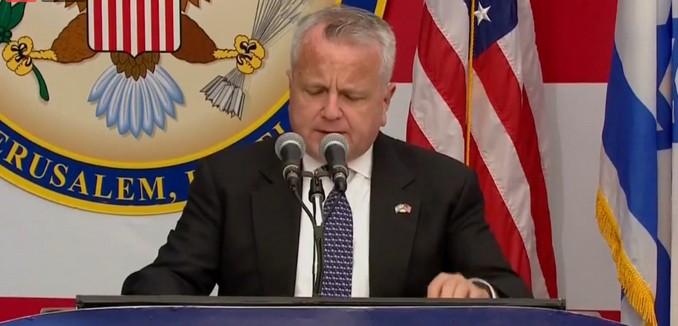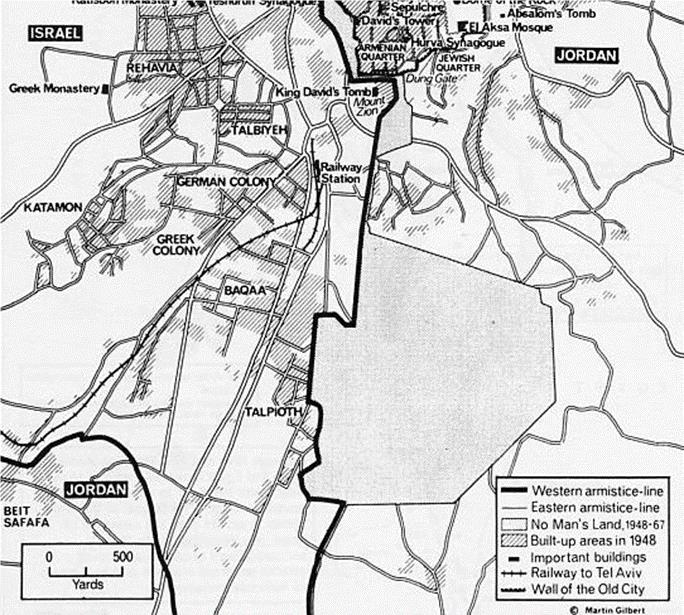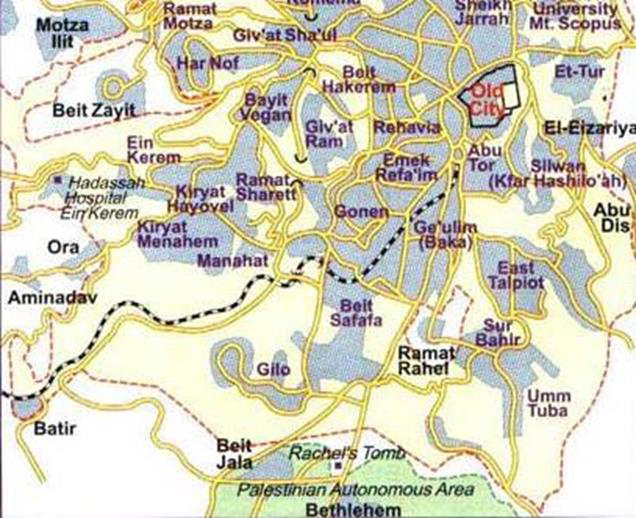Key Facts
1. The embassy move reflects the law. It is a bipartisan effort that has enjoyed cross-party political support in the United States and Israel for decades.
2. Jerusalem is the legitimate capital of Israel. Non-recognition was an aberration – Israel was the only country with no capital recognized by the United States.
3. Israel, like any other nation, has the right to choose its capital. Israel’s historic ties to Jerusalem – which date back over 3,000 years – cannot be rewritten by international institutions.
4. Jerusalem has, in reality, been Israel’s capital and seat of government since 1949. The President’s Residence, the Knesset, the Supreme Court, the Prime Minister’s Office and most government ministries are located in the city.
5. Notwithstanding the embassy relocation, the U.S. does not take a position on the final status of Jerusalem. The U.S. supports two states for two peoples.
6. The new embassy is located at an existing consular building in the Arnona neighborhood of Jerusalem, reflecting continuity of U.S. policy on Jerusalem.
7. Recognition reinforces underscores Israel’s faithful fulfillment of its role as guarantor of complete religious freedom in Jerusalem for all faiths.
The Embassy Act: A Bipartisan Effort
The announcement implements bipartisan Congressional requirements first passed into law over 20 years ago in the Jerusalem Embassy Act of 1995, which were subsequently reinforced in multiple bipartisan motions – most recently in summer of 2017. Republicans and Democrats, in the House, the Senate and the White House, have long supported the decision to recognize Jerusalem as Israel’s capital. The President is simply enacting the law.
The Law
• In 1990, Congress overwhelmingly adopted bipartisan resolutions (H.Con.Res. 290 and S.Con.Res. 106), which acknowledged that Jerusalem “is and should remain the capital of the State of Israel.”
• Jerusalem Embassy Act, November 1995: “Statement of the Policy of the United States: (1) Jerusalem should remain an undivided city in which the rights of every ethnic and religious group are protected. (2) Jerusalem should be recognized as the capital of the State of Israel.”
• Congress overwhelmingly adopted the FY 2003 Foreign Relations Authorization Act in 2002, which requires all government-funded documents that list countries and their capitals to name Jerusalem as the capital of Israel.
• S.Res.176 – a resolution commemorating the 50th anniversary of the reunification of Jerusalem, June 2017: “The Senate… reaffirms the Jerusalem Embassy Act of 1995 as United States law, and calls upon the President and all United States officials to abide by its provisions.”
Bipartisan Political Support
• President Trump, December 2017: “We finally acknowledge the obvious: that Jerusalem is Israel’s capital… I am also directing the State Department to begin preparation to move the American embassy from Tel Aviv to Jerusalem.”
• Senator Charles Schumer, Senate Democratic leader, October 2017: “Moving the embassy as soon as possible would appropriately commemorate the fiftieth anniversary of Jerusalem’s reunification and show the world that the US definitively acknowledges Jerusalem as Israel’s capital.”
• Democratic Senator Bob Menendez, senior member of the senate Foreign Relations Committee, December 2017: “I welcome the announcement from the President affirming established U.S. law that Jerusalem is the capital of Israel and that the Embassy of the United States should reside in the capital. I have always supported moving the United States Embassy to Jerusalem, and have always said it is not a matter of ‘if’ but ‘when.'”
Jerusalem: The Legitimate, Undivided Capital of Israel
For over 3,000 years, Jerusalem has played a central role in the history and identity of the Jewish people. Numerous archaeological excavations have established an undeniable physical, historical, and symbolic link between the Jewish people and Jerusalem.
The long-overdue decision to relocate the embassy reflects the reality on the ground by recognizing that Jerusalem is where Israel’s capital is located, as indeed it has been since 1950. It is the location of parliament, the High Court, and Prime Minister’s office, as well as most major ministries and national institutions.
Fighting the International Delegitimization Campaign
Israel, like all other nations in the world, has the right to choose its own capital. Israel was the only country with no capital recognized by the U.S., an aberration – unless you apply double-standards to the only Jew among nations.
In December 2016, the United Nations Security Council passed a resolution severing Israel’s right to Jerusalem. The resolution fueled even more aggressive anti-Israel efforts, including by UNESCO, which promotes anti-Semitic positions, denying any Jewish connections to Jerusalem. Recognition of Jerusalem as Israel’s capital lays the groundwork for fighting these and similar measures across international forums.
• Zionist Union leader Tzipi Livni ahead of UNESCO’s vote on a resolution calling to recognize Hebron’s Old City—and with it the Cave of the Patriarchs—as a Palestinian World Heritage Site, June 2017: “I lead the opposition in Israel, but not an opposition to the history of my people nor an opposition to the truth (…) These resolutions won’t harm my people’s ties to these sites, but they will harm UNESCO and the ability to advance shared efforts. This is not the way. It prevents cooperation, the kind we are trying to do here today.”
U.S. Support for Two States for Two Peoples
Under the Oslo Accords, Jerusalem is a final status issue which can and will be negotiated between the parties. The U.S. decision to recognize Jerusalem as Israel’s capital and to relocate its embassy is not a position on the final status of Jerusalem; neither is it a recognition of Israel’s sovereignty over East Jerusalem, which the Palestinians claim for their future capital.
The Trump administration has repeatedly stressed its support for the two-state-solution if the parties themselves choose it, as well as its hopes that the decision will inject new momentum into the stalled peace process. The White House is currently working on a wide-reaching peace plan.
• U.S. President Donald Trump, December 2017: “The United States remains deeply committed to helping facilitate a peace agreement that is acceptable to both sides. I intend to do everything in my power to help forge such an agreement. Without question, Jerusalem is one of the most sensitive issues in those talks. The United States would support a two-state solution if agreed to by both sides.”
New Embassy: Relocated in a Historic Place
The new embassy is located at an existing consular building in the Arnona neighborhood of Jerusalem, an area which has been in the hands of Israel since 1948. The building crosses the “1967 lines,” but without touching territory that would be reserved for a Palestinian state – it crosses into what used to be called “no-man’s land,” in between the territory Israelis and Jordanians respectively held 1948-1967. Today, Arnona is situated between the neighborhoods of Talpiot and Ramat Rachel (see maps).
• Daniel B. Shapiro, who served as U.S. ambassador to Israel during the Obama administration, wrote in Foreign Policy in January 2017: The presence of a U.S. Embassy in parts of Jerusalem no one disputes are Israeli territory is one way of acknowledging the centuries of history that link the Jewish people to the city, the questioning of which is closely linked to the denial of Israel’s very legitimacy.
Map I :1948-1967
Map II: Present
Palestinian Incitement: No Obstacle to Relocation
Implementation of the decision to relocate the embassy long delayed by misplaced concerns over Palestinian rejectionism and incitement. The Palestinian leadership’s denial of the Jewish connection to Israel and Jerusalem, and its related incitement to and reward for terror, constitute the greatest obstacle to peace.
• Yair Lapid, the leader of Yesh Atid, December 2017: “Policies should not be dictated by threats and intimidation. If violence is the only argument against moving the embassy to Jerusalem, then it only proves it is the right thing to do.”
• Joshua S. Block, CEO and President of The Israel Project, wrote in The Algemeiner in October 2017: “Moving the embassy isn’t the reason that Palestinian leaders continue to spew out a constant barrage of poison against the Jews. The resentment is far more deep-rooted than that, propagated by central political institutions and celebrated on Palestinian streets. When you name public squares and women centers after terrorists, you are encouraging a culture of hatred. When you celebrate suicide bombers as “martyrs” and role models for Palestinians, you are glorifying violence. When you deny Israel’s right to exist, you are preaching a genocidal ideology.”
Israel’s guarantees religious freedom for all faiths in the Holy City
Israel reunified Jerusalem in 1967 and removed barriers and divisions within Jerusalem, reunited the city, and allowed free movement and worship for Jews, Muslims and Christians. That reversed previous policies which had barred entry to Judaism’s most sacred sites to all Israelis and Jews, and under which further Jewish holy sites were desecrated and destroyed.
In a gesture of peace after the Six-Day War, Israel allowed the Waqf (Muslim religious authorities) to retain its authority over the Temple Mount under the aegis of Jordan.
[Photo: United States Department of State / Facebook]






